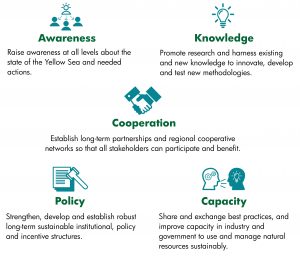The Yellow Sea Partnership was established in 2006 to serve as a multi-stakeholder initiative. It offers a unique stage for its partners to come together at local, national, regional and global scales to meet the many challenges facing the Yellow Sea while embracing friendship, peace, cooperation and prosperity. The overarching aim of the partnership, facilitated by the UNDP/GEF YSLME Phase II Project, is to serve as a platform where partners can work together to implement the YSLME SAP.
Vision
The vision of the Yellow Sea Partnership is to protect, conserve and restore the ecosystem health and natural resources of the Yellow Sea to secure a sustainable and reliable source of food, recreation, livelihoods and also meet the aspirations of all generations into the future.
Mission
The mission of the Yellow Sea Partnership is to bring all stakeholders together at local, national, regional and global levels to ensure that use of the Yellow Sea’s bountiful resources is in line with its natural ecosystem carrying capacity (ECC) while achieving reduction of pollution, recovery of fish stocks and endangered species, and overall ecosystem-based management of the Yellow Sea.
Pillars
The work of the Yellow Sea Partnership is based on the following pillars:

Common Goals
- Reduce the adverse environmental threats and impacts of development activities on Yellow Sea marine environments.
- Promote environmentally-sustainable management and use of the marine and coastal resources in the Yellow Sea.
- Foster mutual knowledge and understanding between people and the environment.
Membership
The Yellow Sea Partnership is open to government, industry, international organizations, academic institutions and other stakeholders. Existing and potential members of the Yellow Sea Partnership are as follows:
Government
Incheon Metropolitan City, RO Korea
Korea Marine Environment Management Corporation (KOEM), RO Korea
Ministry of Finance, PR China
Ministry of Oceans and Fisheries (MOF), RO Korea
Ministry of Foreign Affairs (MOFA), RO Korea
National Marine Environment Monitoring Center (NMEMC) of SOA, PR China
Parliamentary organizations in the two countries
Provincial and local governments of PR China and RO Korea bordering the Yellow Sea
State Oceanic Administration (SOA), PR China
UN Agencies, Global and Regional Institutions and Mechanisms
COBSEA
IOC/WESTPAC
IW:LEARN
NOWPAP
PEMSEA
The GEF
UNDP
UNESCAP-ENEA
UNOPS
Academia
Anyang University, RO Korea
Chungnam National University, RO Korea
First Institute of Oceanography (FIO/SOA), PR China
Hanyang University, RO Korea
Inha University, RO Korea
Institute of Geographic Sciences and Natural Resources Research of Chinese Academy of Sciences (CAS), PR China
Jeju National University, RO Korea
Korea Institute of Ocean Science and Technology (KIOST)
Korea Maritime Institute (KMI)
Korea University
Kunsan University, RO Korea
National Institute of Fisheries Science(NIFS), RO Korea
Pukyoung National University, RO Korea
Yellow Sea Fisheries Research Institute (YSFRI), PR China
NGOs
BlueRibbon Ocean Conservation Association (BOCA), PR China
Bongam Tidal Flat Ecological Center, RO Korea
BuanJulpo Bay Tidal Ecological Park, RO Korea
Conservation International
Dalian Cooperative Young Marine and Coastal Scholar Society (CYMCSS), PR China
East Asian-Australasian Flyway Partnership (EAAFP)
Eco-horizon Institute, RO Korea
Ganghwa People’s Network, RO Korea
Ganghwa Tidal Flat center, RO Korea
Global Village of Beijing (GVB)
Gochang Tidal Flat Visitors’Center, RO Korea
Marine Environment Education Center, RO Korea
Marine Stewardship Council (MSC)
Moolseal, Ganghwa Tidal Flat Education Center, RO Korea
Muan Ecological Tidal Flat Center, RO Korea
Nakdong Estuary Eco Center, RO Korea
Our Sea of East Asia Network, OSEAN, RO Korea
Paulson Institute
Seocheon Bird Ecological Park, RO Korea
Shihwa Life Saver, RO Korea
SiheungGaetgol Eco Park, RO Korea
Sinan Mudflat Center, RO Korea
Suncheon Bay Eco-center, RO Korea
WWF
Wetlands International
Private Sector
Aquaculture Associations












